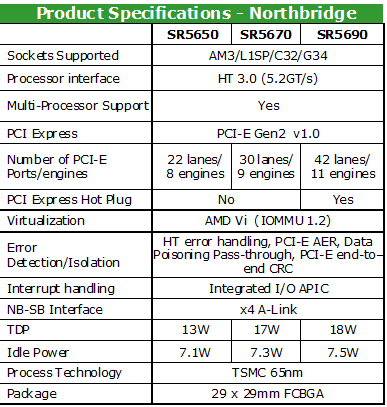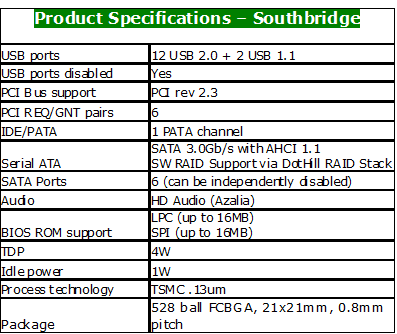AMD's 2010/2011 Roadmap from the IT Professional’s Perspective
by Johan De Gelas on November 23, 2009 12:00 AM EST- Posted in
- IT Computing
At its recent financial analyst day, AMD disclosed processor and platform roadmaps for 2010 and 2011. As the target public consisted mainly of financial analysts, the presentations focused more on AMD’s strategy and competitiveness than on technical accuracy. We had a conference call with John Fruehe and Phil Hughes of AMD and we tried to find out what the new server CPU roadmap means for our readers, the IT professionals who actually configure and buy these servers.
Compared to the mobile and desktop market, AMD is doing relatively well in the server and HPC market. The early delivery of the six-core Opteron (codenamed Istanbul) enabled Cray to build the fastest supercomputer in the world (at least for Q4 2009). It's called the the Cray XT5-HE “Jaguar” with 224162 cores, good for almost 1.76 million GFlops. The Opteron EE made heads turn in the low power cloud computing market, and the six-core Opteron is a good price/performance alternative in the rest of the server world. And last but not least, the 4-socket 84xx Opterons are the unchallenged champions in the quad socket world.
Nevertheless, AMD’s position in the server and HPC market is seriously threatened. An impressive 95 out of the top 500 supercomputers contain Intel's "Nehalem-EP" Xeon 5500 processors. Intel’s star has been rising fast in the HPC market since the introduction of the Intel Xeon 5500. Intel’s Nehalem EX is almost ready to attack the quad socket market. And there's more.
AMD created a very “cool” niche market with the 40W ACP (60W TDP) Opteron EE. Large power limited datacenters bought these CPUs in quantities of a few (and more!) thousands at once. Just a few months ago, Intel also introduced a 45 Watt Xeon L3426 at 1.86 GHz based on their Lynfield core (LGA1156 socket). Considering that AMD’s ACP numbers are rather optimistic and Intel’s TDPs are rather pessimistic, the 8-thread quadcore 1.86 GHz L3426 ($284) makes the six-core 1.8 GHz Opteron 2419EE look expensive ($989). The former can push it’s clock up to 3.2 GHz under single threaded loads, and is thus a really interesting option if your application has a significant part of non-parallel code.
So far AMD has countered Intel’s higher “per core” performance with 50% more cores. Indeed, the six-core Opteron can keep up with the Xeon 5500 in quite a few applications. But Intel is readying a slightly improved six-core version of the Xeon 5500 series called Westmere-EP in the first half of 2010. Being a 32 nm high-K dielectric CPU, the six-core Westmere-EP wil offer about the same power consumption with six-cores under load as the quadcore Xeon 5500 (Nehalem EP). At idle, Westmere-EP will consume less (14 to 22% less leakage). Westmere-EP’s architecture is identical to that of the Nehalem EP, with the exception of a 50% larger L3 cache (12 instead of 8 MB) and support for special AES instructions.
AMD's Answer
It was hardly noticeable but AMD made a historic step forward in September 2009 with the introduction of it’s own server chipsets. For the first time, AMD is a real server platform supplier, in control of both the CPU and chipset. The previous AMD server platform was mostly based on NVIDIA's nForce 3600 Pro. The nForce 3600 gave some system administrators quite a few headaches, especially in combination with VMware’s ESX. VMware’s ESX installed flawlessly on all Intel platforms we have tried so far, but it was unpredictable whether or not an nForce board would work with ESX. Of course, the added value of a tier one OEM is that they sort these things out and offer you a driver + hardware platform that is certified for ESX and others. So you could say that this was a non-issue for HP, SUN and Dell buyers (I have hardly seen any IBM Opteron based servers in the wild). Still, it is good to see that AMD is now completely responsible and in charge of it’s own server platform.


At the moment, the impact of the “Fiorano” or SR56xx chipsets is negligible. Most server vendors are preparing the servers based on the C32 socket and G34 socket and don’t feel like investing in the socket-F server platform which is at the end of its long road. Only Tyan and Supermicron, which focus mostly on the HPC market, offer servers based on the AMD SR5690 chipset right now.










107 Comments
View All Comments
Marianot - Saturday, August 29, 2020 - link
https://sirhcchris2010.sltoos.info/zGik2pd1pKhpy4I...">[img]https://i.ytimg.com/vi/g7nt5Anq8fM/hqdefault.jpg[/img]I https://sirhcchris2010.sltoos.info/zGik2pd1pKhpy4I...">Took Free Kicks Until I Became Better Than Messi (not even clickbait)
MistyHit - Saturday, August 29, 2020 - link
https://streetspeed717.alworld.info/guy-in-a-1-000...">[img]https://i.ytimg.com/vi/k8oX-c8unyw/hqdefault.jpg[/img]GUY in a 1,000HP Mustang Says He Can BEAT My ZR1 (Why I'll NEVER https://streetspeed717.alworld.info/guy-in-a-1-000...">Race Him Again)
CynthiaCip - Sunday, August 30, 2020 - link
https://mattandrebecca.kgworld.info/maddie-is/u7KG...">[img]https://i.ytimg.com/vi/WNOM7uj9Mi0/hqdefault.jpg[/img]Maddie is Best Friends https://mattandrebecca.kgworld.info/maddie-is/u7KG...">with a RHS Hacker? Camera Roll reveals Secret Unlisted Video
VanessaKek - Sunday, August 30, 2020 - link
https://agresivniridic.csshows.info/vybrzdovani-pr...">[img]https://i.ytimg.com/vi/Jv2ox68GvjY/hqdefault.jpg[/img]VybrЕѕДЏovГЎnГ, PЕ™edjГЕѕdД›nГ pЕ™es plnou ДЌГЎru, https://agresivniridic.csshows.info/vybrzdovani-pr...">AgresivnГ Е™idiДЌ, Dashcam
CeliaMeecy - Monday, August 31, 2020 - link
https://unboxtherapy.trwatch.info/you-ll/fJulmpO_g...">[img]https://i.ytimg.com/vi/Icn5-YPcBZk/hqdefault.jpg[/img]You'll Never https://unboxtherapy.trwatch.info/you-ll/fJulmpO_g...">Share Earbuds Again...
Juliated - Monday, August 31, 2020 - link
https://tseries.plclip.info/PCgzlungCK8-dil-ko-mai...">[img]https://i.ytimg.com/vi/PCgzlungCK8/hqdefault.jpg[/img]Dil https://tseries.plclip.info/PCgzlungCK8-dil-ko-mai...">Ko Maine Di Kasam Full Audio Amaal M Ft.Arijit S,KumaarAsim R,Himanshi K Bhushan Kumar
LorettaOccaf - Tuesday, September 1, 2020 - link
https://gan13.kzhead.info/dKigms9vm6mnZoU/novye-va...">[img]https://i.ytimg.com/vi/ADgjk7dwq3M/hqdefault.jpg[/img]https://gan13.kzhead.info/dKigms9vm6mnZoU/novye-va...">НОВЫЕ Р’РђРМ†РќР« (#gan_13_)
MaryannMoubs - Wednesday, September 2, 2020 - link
https://formula1.hufast.info/top-10/gWrKeNeel56poH...">[img]https://i.ytimg.com/vi/L4hCri3lEoI/hqdefault.jpg[/img]Top 10 Tyre Dramas https://formula1.hufast.info/top-10/gWrKeNeel56poH...">In F1
Laurakeera - Wednesday, September 2, 2020 - link
https://kittisaurus.usworlds.info/run-lulu-run-ext...">[img]https://i.ytimg.com/vi/PFEbc5lunH0/hqdefault.jpg[/img]Run LuLu https://kittisaurus.usworlds.info/run-lulu-run-ext...">Run Extreme Cat Wheel WorkoutKittisaurus
Aliciabusty - Thursday, September 3, 2020 - link
https://mrorganik.uzpost.info/unbelievable-news/jp...">[img]https://i.ytimg.com/vi/U0c8w9L6oXI/hqdefault.jpg[/img]UNBELIEVABLE NEWS ABOUT MY https://mrorganik.uzpost.info/unbelievable-news/jp...">FORGIATO Rims